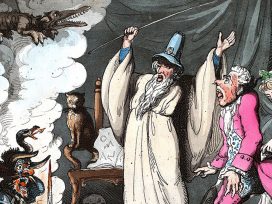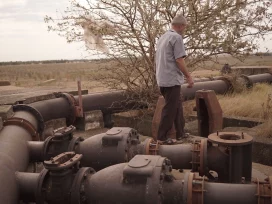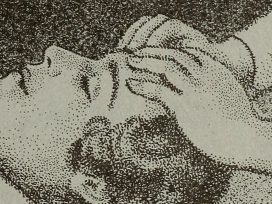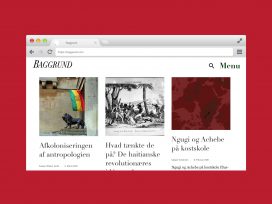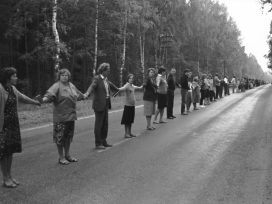I first witnessed a Victory Day parade in St Petersburg in 1995. Back then I found the huge crowd and the palpable emotions impressive. Each of the fifty salvos, fired as salutes from allied war ships on the Neva River, was accompanied by people shouting ‘hurrah’ with one voice. Like many others, I had bought a little flag with the Soviet slogan Miru mir (Peace to the World); others, mostly children, were carrying balloons. Twenty-seven years later, displaying my (post-)Soviet flag in St Petersburg would result in immediate arrest.
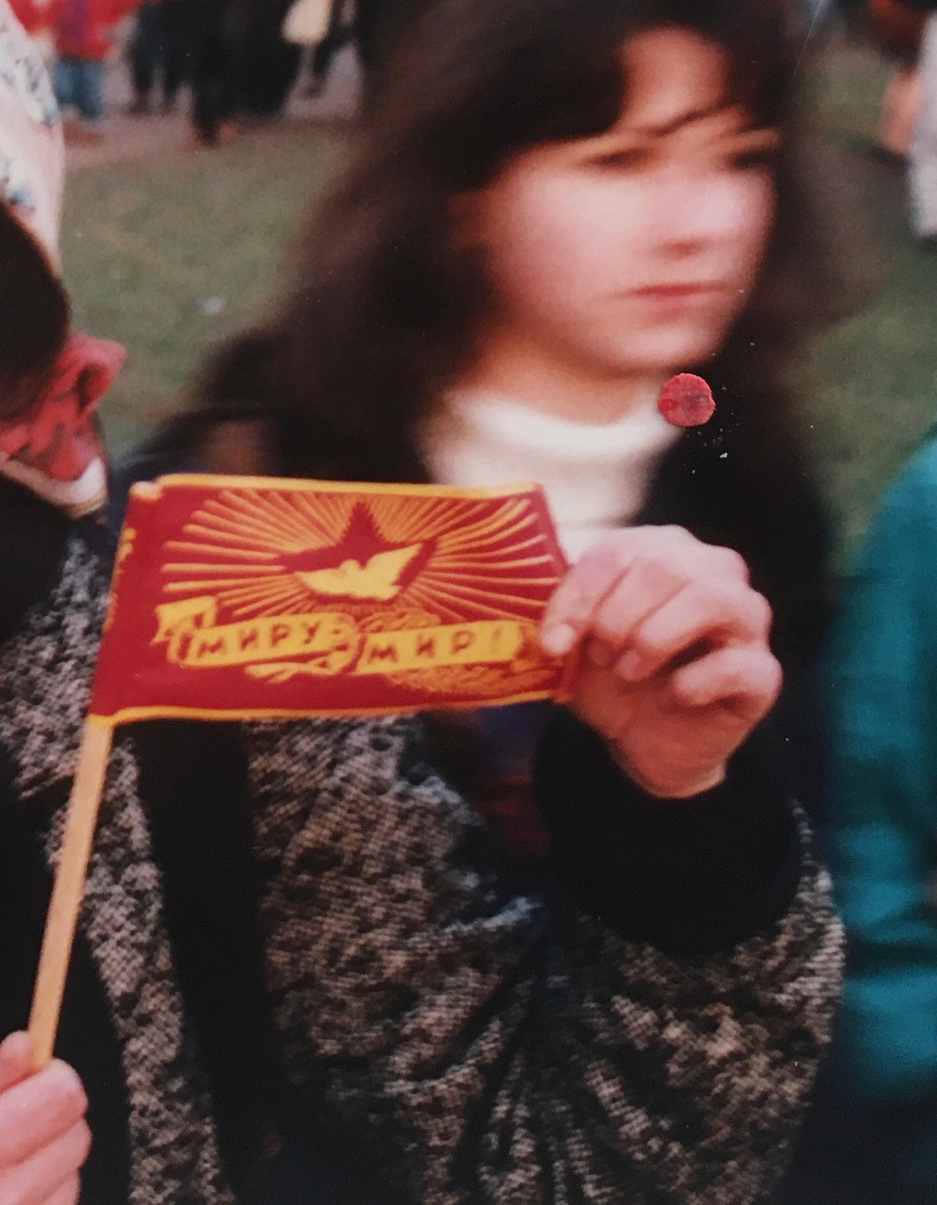
Victory Day in St Petersburg, 9 May 1995
Since the Russian invasion of Ukraine on 24 February 2022, much has been said about the ‘war of memory’ and successful resurrection of the Soviet cult of war. That any public critique and even use of the words ‘war’ and ‘peace’ could be criminalized seems an unprecedented ideological turn for the generation of Russians whose memory of the Great Patriotic War was intrinsically linked with the conviction ‘Never again!’ Yet, this shift seems to distress only a minority.
Not only the attack itself but also the widespread support of what is clearly a fully-fledged, brutal war has taken observers by surprise. It is hard to know exactly how many Russians support their country’s ‘special operation’, as the war is officially called. Yet distressed comments in private conversations and on social media by those who mourn the loss of ‘zombified’ parents, family members or friends testify to the fact that state propaganda has been successful in convincing a significant proportion of Russian society of an alleged ‘rightfulness’ of Russia’s military action in Ukraine and the need to shun ‘traitors’. Moreover, a considerable number of those who might not explicitly support military action simply chose to look away – out of comfort, self-protection, or, perhaps, fear.
How can the loyalty or blindness, which seems to contradict lifelong convictions of middle-aged and elderly Russians, be explained? In 2009 and 2010, when I returned to St Petersburg to conduct field research for my PhD project on the coping mechanisms of survivors of the Siege of Leningrad, few people understood my unease about drip-fed war-glorifying propaganda, which at times caused me physical nausea.
By that time, ‘Peace to the World’ flags had been replaced with new patriotic symbols – namely the St. George’s ribbon and the Russian flag. The new symbols even pleased many survivors, who did not or chose not to notice the change of tone and continued to participate in official activities.
What follows are excerpts from the forthcoming book The Last Heroes of Leningrad: Coping strategies of Siege Survivors in Soviet and post-Soviet Society. With reference to Dominick LaCapra’s writings about history and trauma, it discusses why many survivors, who spent their lives hoping to finally tell the ‘whole truth’ about the Siege of Leningrad, voluntarily returned to old patterns of behaviour during the short period of relative freedom in the 1990s. Survivors of the Siege are but a declining minority in contemporary Russian society. I leave it to others to judge whether or not my observations from the years 2009–2010 have relevance for other parts of Russian society.
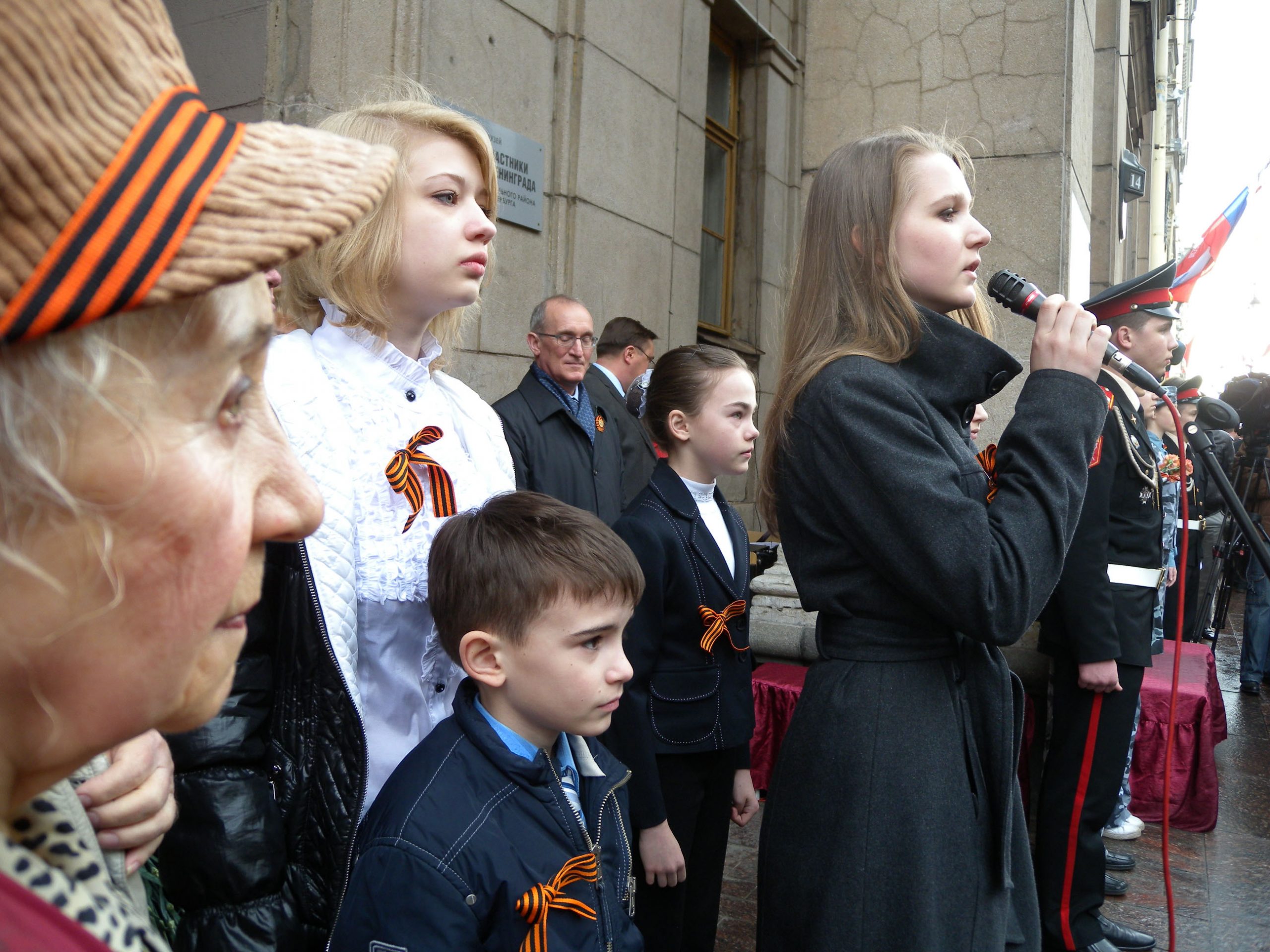
Children and adolescents at a wreath laying ceremony outside the museum ‘Young Participants in the Defence of Leningrad’, Nevskii Prospekt 14, 8 May 2010
“We educate patriots.”
Around memorial dates, the offices of St Petersburg’s two large Siege survivors’ organizations turn into a kind of headquarters where participants of ceremonies, parades and meetings gather, and exchange information and opinions. Once the official programme is over, there is time for less formal gatherings.
On 10 September 2010, representatives of ‘Inhabitants of Besieged Leningrad’ welcomed fellow Siege survivors from Moscow. Ekaterina A., a former teacher and ‘memorial activist’ from St Petersburg, took to the floor and addressed what, in her understanding, constitutes the core work of survivors’ organizations: ‘You and us, we are doing a big thing: We educate patriots. And this is a lot in our times, and it is wonderful!’
This statement illustrates that twenty years after the collapse of the Soviet Union Siege survivors supported the massive patriotic propaganda that they were subjected to as children prior, during and immediately after the Siege, and which was used again from the mid-1960s to turn young Russians into loyal Soviet citizens.
The ‘education of children and youths using the example of Leningraders’ heroism’ is embedded in the articles of association of survivors’ organizations, and individual survivors are invited to play an active role in the narration of an idealized past. While not all of them are aware of the propagandistic exploitation of their personal history, the goal of such activities is practically the same as it was in Soviet times: to nurture the spirit of patriotism, enthusiasm for military service and loyalty to state ideology.
‘I remember. I take pride.’
In 2001 the first ‘State programme for the patriotic education of citizens of the Russian Federation’ was introduced. It covered the years 2001 to 2005 and was renewed for another five years in 2005, 2010, 2016 and 2021. A kind of five-year-plan for the education of patriots, the programme intended to safeguard the ‘continual formation of patriotic awareness among Russian citizens as one of the factors for a united nation’. The list of about 150 measures defined which actors were to undertake which activities, the funds reserved for them and, most importantly, the anticipated results. These included: the promotion of the Russian economy, respect for the elderly, the preservation of ‘patriotic’ interpretations of the past and legislative prerequisites for patriotic educational work.
With its strong focus on the preparedness for combat and the memory of the Great Patriotic War, the programme indeed evokes memories of the ‘military-patriotic upbringing’ under Brezhnev. It combines ‘traditional forms of educational work that established themselves in the past’ with the use of technical innovation.
In St Petersburg children accompany survivors to the monument ‘Flower of Life’, perform wartime marches and hang red neck ties on the trees of the ‘Alley of Friendship’. They write essays about the heroic deed of Leningraders, research the history of the Siege at the former Pioneer Palace (now Palace for the Creative Work of Young People) and perform at festive concerts. ‘Lessons of courage’ are an integral part of class schedules and abandoned school museums are being revived, often under the supervision of survivors.
Through their engagement with ‘military-patriotic education’, Siege survivors, directly or indirectly, support the idea that children should be prepared to die for their country. It is rare for survivors to associate their own suffering as a child with the potential consequences of military engagement for today’s children.
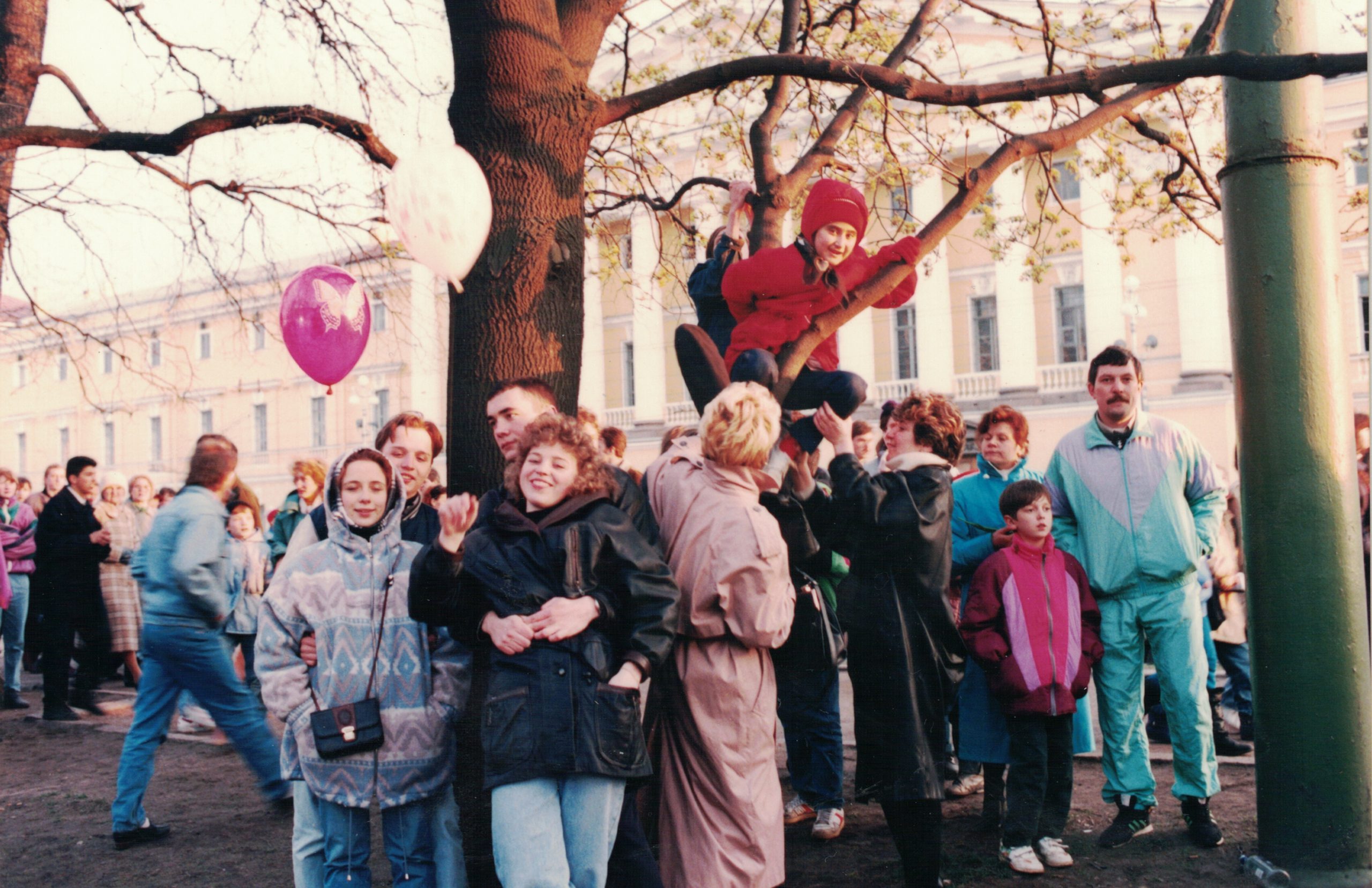
Victory Day celebrations in St Petersburg, 1995
In the opinion of the Siege orphan and politician Selivanov, ‘the moral significance and the meaning of the deed of young Leningraders is not always clear to today’s schoolchildren’ – the suggestion being that children are not sufficiently aware that they must be prepared to make sacrifices like those during the Siege and survivors therefore need to explain this to them. But seen from a less ideological point of view, it is not at all clear why survivors, who barely escaped death themselves, would want children to be prepared to die, even if it was ‘for the Fatherland’.
The engagement of child survivors might partly be ascribed to a general nostalgia for a time when they were personally and professionally settled, and when their role as eyewitnesses suddenly gained importance in society. The silence that had been imposed on the Siege in the late 1940s was replaced by clear messages and respect for survivors. At the same time, the private and public silence about what had happened to child survivors during the Siege could hardly have been without effect. In many families Siege memories were not discussed, nor were schools a source of information.
Us little girls and boys, we played ‘war’ and we came to the courtyard, and stacks were burning: they burnt everything, of course, and Germans were working: They restored our houses. I remember all that. No, we did not learn about the blockade in school. It was real for us, why should we have studied it. In 1948 we still had ration cards, and Leningraders who had been blokadniki were still alive. A living legend, so to speak, here we [unintelligible] it, so to speak, but that they would have taught it in schools, no, I don’t remember that, and I think that it did not happen.
Regardless of what was taught in schools, children sensed the tragedy, distress and grief of their surroundings. And they had their own distressing memories of which they needed to make sense.
Research on children and war has shown that adults are often not aware of the effects violent conflicts have on children, are too distressed themselves to take care of the emotional needs of children, or tend to think that not addressing grievous topics is the best protection for children. Even those who are able to give support often believe, well-meaningly, that by keeping certain topics secret they would be able to spare children the tortures of bad memories.
As James Roffey has noted in the context of British children who were evacuated during the war: ‘If they tried to relate their experiences they would be brusquely told to “Forget the evacuation, it’s all over, live for the present.”’ Many children did not even have parents who could have potentially helped them and had to rely on child care workers for emotional support. Even if they were lucky enough to have empathetic nurses or teachers, these, too, would often apply similar strategies as parents.
Catriona Kelly quotes a Soviet orphanage worker who laid out the principles adopted towards children who had ‘suffered terrible experiences during the war’, among them the recommendation ‘to ask the children no questions whatsoever, to protect them from recollections of what they had lived through’.
Patriotic propaganda, thus, was the only source of explanation and consolation for many children. Even if affirmations like ‘in our state children are surrounded by special attention, care and love’ stood in contrast with their own experiences, they nevertheless subdued feelings of helplessness and senselessness – feelings that pose a serious threat to the psychological integrity of a child when left alone with them.
Memorial dates are also used to frame Victory celebrations with pseudo-scientific events. On 7 May 2010, Piskarevskoe Memorial Cemetery organized the ‘International Conference dedicated to the 65th Anniversary of the Victory of the Soviet People in the Great Patriotic War of the years 1941–1945 and the 50th Anniversary of the opening of the Piskarevskoe Memorial complex’. It presented the local who’s who of the Siege politics of memory.
The ‘internationality’ of the event was justified by two guest speakers, Paweł Machcewicz, founding director of the Museum of World War II in Gdańsk, Poland (until 2017), and the German consul general in St Petersburg (2008–2011), Peter Schaller. The speakers, experienced in this type of event, presented their usual congratulations, appeals and sermons, without offering any surprises. The speeches ranged from presentations of patriotic-educational projects and pleas to safeguard the ‘truth’ about the blockade to homages to Stalin as the great leader of Victory.
They reliably met the expectations of organizers and the audience, as formulated in the conference programme: the preservation of the memory of the Great heroic deeds of the peoples who defeated fascism; raising the interest of citizens in the history of war; nurturing the feeling of pride among young people for the deeds of the older generation and for their Fatherland; and acting against attempts to falsify the historical battles of the Great Patriotic War and the role of the Soviet Union, and of its allied countries in the Second World War.
The only disturbing factors were the international guests, who stepped from the agreed line, both in content and wording. Paweł Machcewicz, in a professional and engaged presentation, outlined the concept of the planned museum. He was met with politeness until the moment when he stressed that the museum will also cast light on the crimes of Katyn.
Peter Schaller had serious difficulties in reaching the audience. When he stepped up to read his address, the sound system collapsed and his speech was postponed. After the break he made a second attempt in front of a considerably smaller audience. But most listeners took off their headphones providing translation. Several participants demonstrated their disinterest by talking amongst themselves.
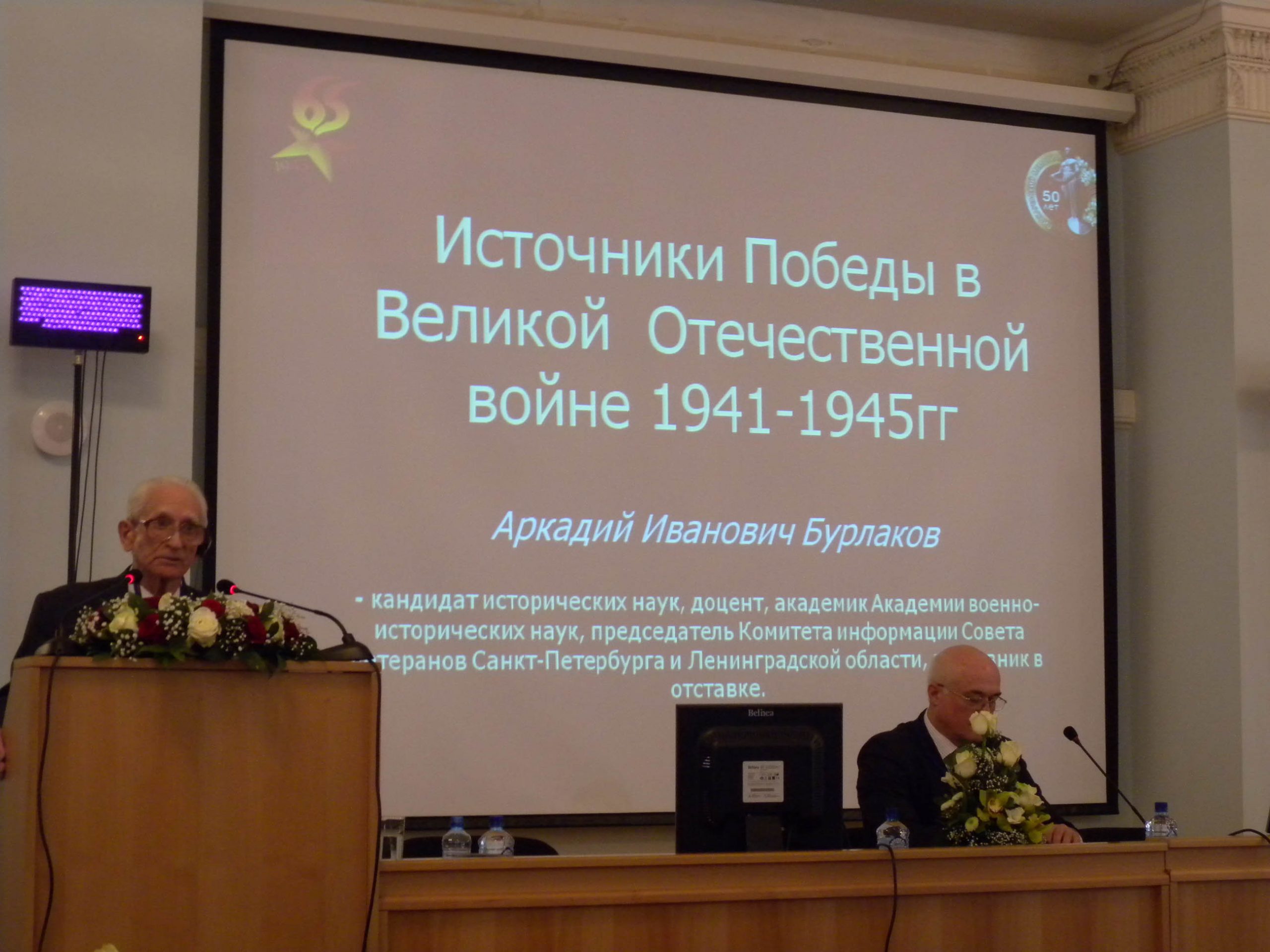
Arkadii I. Burlakov speaking about ‘The Sources of Victory in the Great Patriotic War 1941–1945’, 7 May 2010.
I left the ‘conference’ numbed, with a feeling of malaise. To clarify what exactly had caused this reaction, I sat down to take notes. The association that forced itself upon me was the image of a corset, an iron straitjacket which not only imprisons its wearer but also has life-saving functions, protecting its fragile contents from collapse.
This image was so strong that it immediately resurfaced when I came across the notion of ‘protective armour’ in the writings of the trauma expert Peter Levine. Levine examines trauma from a biological point of view and describes it as a condition of immobility which is mutually exclusive with the experience of emotions. These emotions threaten to overwhelm the individual and therefore need to be banned.
The combination of silence and propaganda, which glamorized the past, acted as an anaesthetic but prevented a more critical appraisal. ‘Patriotic’ convictions were deeply engrained and preserved beyond childhood, as they offered an explanation and kept the pain associated with the blockade at distance. It is therefore unsurprising that many child survivors actively participated in the re-enactment of this propaganda when the Siege was discovered as an ideal topic for ‘shaming’ increasingly unenthusiastic young citizens into ‘good behaviour’ from the second half of the 1960s.
When these practices were revived and new ones introduced in the 2000s, they continued their engagement. The ‘State programme for the patriotic education of citizens of the Russian Federation’ tells them how to do so. ‘I remember, I take pride’ reduces the past to a slogan that better fits the contemporary needs of the Russian leadership, and makes remembering easy.
It is true that clinging onto Soviet-type propaganda messages has considerable practical implications. I agree that the Siege experience is valuable symbolic capital which is used by survivors’ organizations to gain a maximum of benefits, financial and symbolic. But, I believe, the image of an ‘iron corset’ cannot sufficiently be explained by the fight for benefits alone. That survivors did not object to the disappearance and, ultimately, to the criminalization of the Soviet slogan ‘Peace to the World’ suggests that many have not been able to fully process their traumatic experiences.
The Last Heroes of Leningrad: Coping strategies of Siege survivors in Soviet and post-Soviet Society is due for publication in June 2022 in the series Zeitgeschichte im Kontext, Vienna University Press.
